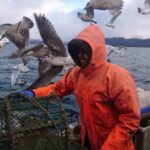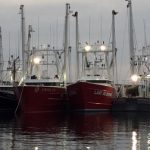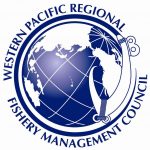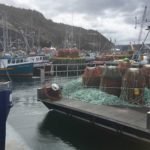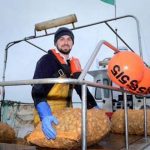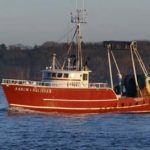Tag Archives: D.B. Pleschner

D.B. Pleschner: Is court the right place to determine ‘best available science’?
A U.S. District Court judge recently ruled that the federal government’s catch limit for California’s central stock of anchovy — currently 25,000 metric tons — is far too high. But instead of weighing all the facts, the judge ignored them, shunned the established precedent of deference to federal agencies’ scientific determinations and instead endorsed the flawed arguments of the advocacy group Oceana. So what happened? >click to read< 21:55
D.B. Pleschner: Nearshore anchovy abundance not proof fishery is collapsing
 Recently, Dr. William Sydeman of the Farallon Institute, published a study claiming that the abundance of anchovy near shore — especially in places like Monterey — is evidence that the population is collapsing. Sydeman’s logic is based on an old argument that collapsed populations always shrink inshore. But there’s one big problem with that theory — it’s unsupported by scientific evidence.,,, The bottom line: environmental groups with an anti-fishing agenda are already gearing up to hot-box the Pacific Fishery Management Council in spring 2018, lobbying for a steep reduction in anchovy harvest limits, employing whatever colorful, sensational pictures they can paint. click here to read the story 20:58
Recently, Dr. William Sydeman of the Farallon Institute, published a study claiming that the abundance of anchovy near shore — especially in places like Monterey — is evidence that the population is collapsing. Sydeman’s logic is based on an old argument that collapsed populations always shrink inshore. But there’s one big problem with that theory — it’s unsupported by scientific evidence.,,, The bottom line: environmental groups with an anti-fishing agenda are already gearing up to hot-box the Pacific Fishery Management Council in spring 2018, lobbying for a steep reduction in anchovy harvest limits, employing whatever colorful, sensational pictures they can paint. click here to read the story 20:58
D.B. Pleschner: Study: No correlation between forage fish, predator populations
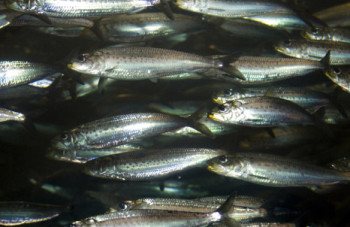 On April 9-10, the Pacific Fishery Management Council is meeting in Sacramento to deliberate on anchovy management and decide on 2017 harvest limits for sardine, two prominent west coast forage fish. Extreme environmental groups like Oceana and Pew have plastered social media with allegations that the anchovy population has crashed, sardines are being overfished and fisheries should be curtailed, despite ample evidence to the contrary. Beyond multiple lines of recent evidence that both sardines and anchovy populations are increasing in the ocean, a new study published this week in the journal Fisheries Research finds that the abundance of these and other forage fish species is driven primarily by environmental cycles with little impact from fishing, and well-managed fisheries have a negligible impact on predators — such as larger fish, sea lions and seabirds. This finding flies directly in the face of previous assumptions prominent in a 2012 study commissioned by the Lenfest Ocean Program, funded by the Pew Charitable Trusts, heirs of Sun Oil Company. The Lenfest study concluded that forage fish are twice as valuable when left in the water to be eaten by predators and recommended slashing forage fishery catch rates by 50 to 80 percent. click here to continue reading the article 20:39
On April 9-10, the Pacific Fishery Management Council is meeting in Sacramento to deliberate on anchovy management and decide on 2017 harvest limits for sardine, two prominent west coast forage fish. Extreme environmental groups like Oceana and Pew have plastered social media with allegations that the anchovy population has crashed, sardines are being overfished and fisheries should be curtailed, despite ample evidence to the contrary. Beyond multiple lines of recent evidence that both sardines and anchovy populations are increasing in the ocean, a new study published this week in the journal Fisheries Research finds that the abundance of these and other forage fish species is driven primarily by environmental cycles with little impact from fishing, and well-managed fisheries have a negligible impact on predators — such as larger fish, sea lions and seabirds. This finding flies directly in the face of previous assumptions prominent in a 2012 study commissioned by the Lenfest Ocean Program, funded by the Pew Charitable Trusts, heirs of Sun Oil Company. The Lenfest study concluded that forage fish are twice as valuable when left in the water to be eaten by predators and recommended slashing forage fishery catch rates by 50 to 80 percent. click here to continue reading the article 20:39
D.B. Pleschner: ENGO Extremists manufacture anchovy ‘crisis’ where none exists
 When the National Marine Fisheries Service (NMFS) recently reapproved the 2017 annual catch limit for the central stock of anchovy at 25,000 metric tons (mt), environmental extremists immediately cried foul. Press releases with doomsday headlines claimed that the anchovy catch limit is now higher than the total population of fish in the sea. Environmentalists claim the anchovy resource has “collapsed” and the current catch limit is dangerously high. But is the anchovy population really decimated, or are these alarmists simply manufacturing another anti-fishing crisis? In reality, anchovies are now amazingly abundant from San Diego to Northern California. Scientific data as well as fishermen’s observation bear this out: Read the op-ed here 12:22
When the National Marine Fisheries Service (NMFS) recently reapproved the 2017 annual catch limit for the central stock of anchovy at 25,000 metric tons (mt), environmental extremists immediately cried foul. Press releases with doomsday headlines claimed that the anchovy catch limit is now higher than the total population of fish in the sea. Environmentalists claim the anchovy resource has “collapsed” and the current catch limit is dangerously high. But is the anchovy population really decimated, or are these alarmists simply manufacturing another anti-fishing crisis? In reality, anchovies are now amazingly abundant from San Diego to Northern California. Scientific data as well as fishermen’s observation bear this out: Read the op-ed here 12:22
Antiquities Act Proposal would devastate California’s fishing industry – D.B. Pleschner
 California’s fisheries provide healthy, sustainable food, but that could change under a dangerous new proposal being circulated, until recently, behind closed doors at the Legislature. California’s fishing community – more than 40 harbors, chambers of commerce, seafood processors and recreational and commercial fishing groups – has united to oppose the proposal to declare virtually all offshore seamounts, ridges and banks off the coast as monuments under the Antiquities Act and permanently close these areas to commercial fishing. After pursuing rumors, fisheries groups discovered the proposal, along with a sign-on letter encouraging legislative support. But no one bothered to seek any input from recreational and commercial fishermen. Even worse, there has been no scientific review or economic analysis, no public participation and no transparency. Read the rest here 10:46
California’s fisheries provide healthy, sustainable food, but that could change under a dangerous new proposal being circulated, until recently, behind closed doors at the Legislature. California’s fishing community – more than 40 harbors, chambers of commerce, seafood processors and recreational and commercial fishing groups – has united to oppose the proposal to declare virtually all offshore seamounts, ridges and banks off the coast as monuments under the Antiquities Act and permanently close these areas to commercial fishing. After pursuing rumors, fisheries groups discovered the proposal, along with a sign-on letter encouraging legislative support. But no one bothered to seek any input from recreational and commercial fishermen. Even worse, there has been no scientific review or economic analysis, no public participation and no transparency. Read the rest here 10:46
D.B. Pleschner: Pacific Sardines are not collapsing, may be in recovery
 On April 10, the Pacific Fishery Management Council closed the West Coast sardine fishery for a second straight year. The council followed its ultra-conservative harvest control policy and relied on a stock assessment that does not account for recent sardine recruitment. But in fact, there are multiple lines of evidence that young sardines are now abundant in the ocean. In addition to field surveys, fishermen in both California and the Pacific Northwest have been observing sardines – both small and large — since the summer of 2015. And California fishermen also provided samples of the small fish to federal and state fishery managers. Read the rest here 19:29
On April 10, the Pacific Fishery Management Council closed the West Coast sardine fishery for a second straight year. The council followed its ultra-conservative harvest control policy and relied on a stock assessment that does not account for recent sardine recruitment. But in fact, there are multiple lines of evidence that young sardines are now abundant in the ocean. In addition to field surveys, fishermen in both California and the Pacific Northwest have been observing sardines – both small and large — since the summer of 2015. And California fishermen also provided samples of the small fish to federal and state fishery managers. Read the rest here 19:29
D.B. Pleschner: Anchovy collapse simply a manufactured ‘crisis’
 If you follow news about the Monterey Bay, you’ve undoubtedly heard the recent outcry by environmentalists in the media claiming the anchovy population in California has collapsed and the fishery must be closed immediately. The current controversy stems largely from a study funded by environmental interests that claims an apocalyptic decline of 99 percent of the anchovy population from 1951 to 2011. However, fishermen have seen a surge in anchovies in recent years. Read the rest here 20:19
If you follow news about the Monterey Bay, you’ve undoubtedly heard the recent outcry by environmentalists in the media claiming the anchovy population in California has collapsed and the fishery must be closed immediately. The current controversy stems largely from a study funded by environmental interests that claims an apocalyptic decline of 99 percent of the anchovy population from 1951 to 2011. However, fishermen have seen a surge in anchovies in recent years. Read the rest here 20:19
D.B. PLESCHNER: Recent Fishery Study Debunked by 1,400 Years of Data
 In an article in International Business Times (August 5, 2015), Aditya Tejas quoted researcher Malin Pinsky in his recently published paper that claims smaller, faster-growing fish like sardines and anchovies are more vulnerable to population collapses than larger fish. While it’s common these days to blame the ocean’s woes on overfishing, the truth is Pinsky’s conclusions don’t paint a complete picture. Fortunately, we do have an accurate picture and it’s definitely better than the proverbial thousand words. Read the rest here 20:56:09
In an article in International Business Times (August 5, 2015), Aditya Tejas quoted researcher Malin Pinsky in his recently published paper that claims smaller, faster-growing fish like sardines and anchovies are more vulnerable to population collapses than larger fish. While it’s common these days to blame the ocean’s woes on overfishing, the truth is Pinsky’s conclusions don’t paint a complete picture. Fortunately, we do have an accurate picture and it’s definitely better than the proverbial thousand words. Read the rest here 20:56:09
Another View: Sardine population isn’t crashing by D.B. Pleschner
 Environmental groups such as Oceana complain that the sardine population is collapsing just as it did in the mid-1940s. They blame “overfishing” as the reason and maintain that the fishery should be shut down completely (“Starving sea lions spotlight overfishing,” Viewpoints, April 14). In truth, Pacific sardines are perhaps the best-managed fishery in the world. The current rule – established in 2000 and updated last year with more accurate science – sets a strict harvest guideline. Read the rest here 10:25
Environmental groups such as Oceana complain that the sardine population is collapsing just as it did in the mid-1940s. They blame “overfishing” as the reason and maintain that the fishery should be shut down completely (“Starving sea lions spotlight overfishing,” Viewpoints, April 14). In truth, Pacific sardines are perhaps the best-managed fishery in the world. The current rule – established in 2000 and updated last year with more accurate science – sets a strict harvest guideline. Read the rest here 10:25
D.B. Pleschner: Sardines are not being overfished
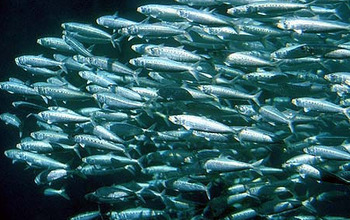 In recent weeks, sardines have been a hot news topic again. Environmental groups like Oceana complain that the sardine population is collapsing just like it did in the mid-1940s. They blame “overfishing” as the reason and maintain that the fishery should be shut down completely. Today, in truth, Pacific sardines are perhaps the best-managed fishery in the world — the poster fish for effective ecosystem-based management,,, Read the rest here 08:50
In recent weeks, sardines have been a hot news topic again. Environmental groups like Oceana complain that the sardine population is collapsing just like it did in the mid-1940s. They blame “overfishing” as the reason and maintain that the fishery should be shut down completely. Today, in truth, Pacific sardines are perhaps the best-managed fishery in the world — the poster fish for effective ecosystem-based management,,, Read the rest here 08:50

































